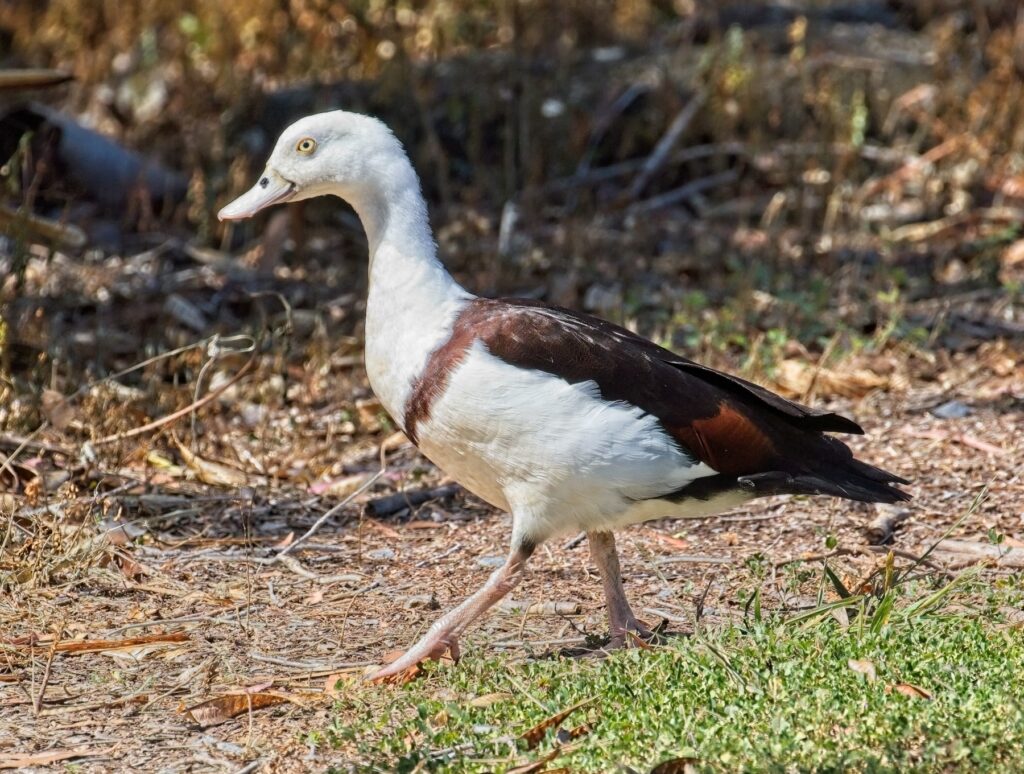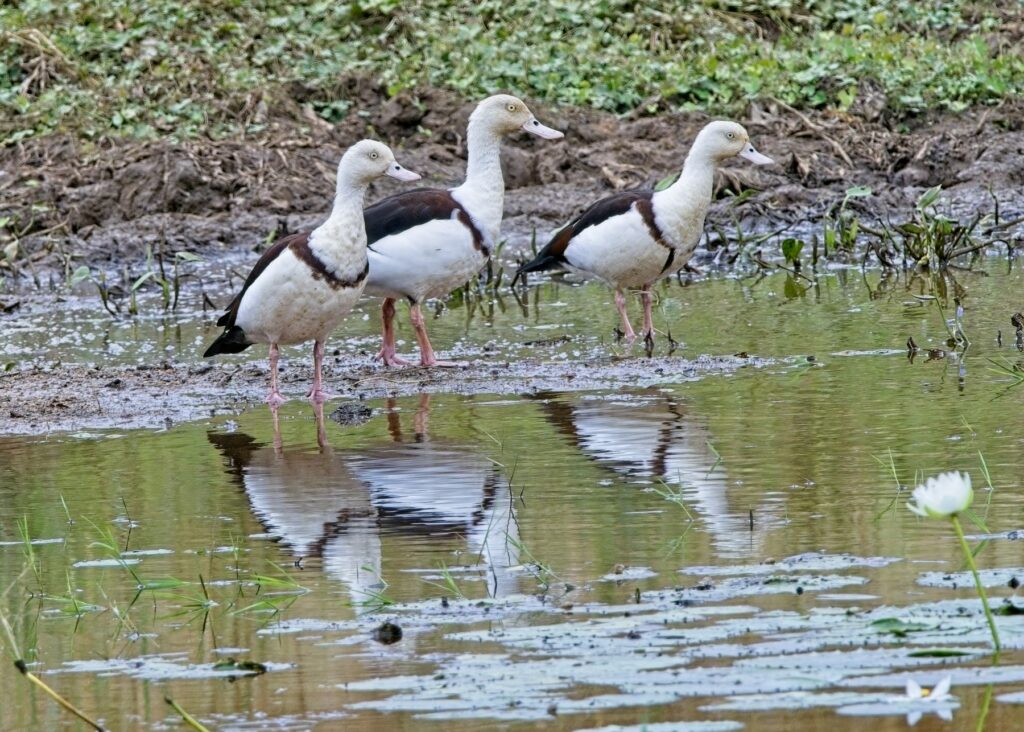Several years ago, I rode my bicycle out to Luggage Point, near the mouth of the Brisbane River, and found a pair of Radjah Shelducks (Radjah radjah) standing in a roadside puddle. (Perhaps the same birds that were observed by multiple other birders, although I did not know this at the time.) This encounter showed two of the key characteristics of this species. The first is that they are often found in pairs (with the female having a slightly thinner dark breast band), and secondly that they prefer to forage in shallow water, often near mangrove-lined river mouths. While Radjah Shelducks will move around locally, particularly during the non-breeding season, they are not are prone to wander widely. The pair I saw was well south of the regular range of the species, but a small number of Radjah Shelducks are resident along the central coast of Queensland and, many years ago (until the end of the 19th century), the species was established as far south as northern NSW. This species is not particularly tolerant of human presence and increasing development likely underlies the reduction in its historic range.

The Radjah Shelduck is a large, handsome waterfowl of northern Australia, which, although not rare, is sufficiently uncommon for sightings to be notable. It is one of the world’s 7 species of shelduck, but is considered sufficiently taxonomically distinct (e.g. Sraml et al., 1996) from the other six species (which are placed in the genus Tadorna) to warrant it’s own genus (Radjah). Two subspecies of the Radjah Shelduck are recognized, R. r. rufitergum in Australia and R. r. radjah on New Guinea, the Moluccas, and some nearby islands. A recent genetic study (Seibert et al., 2023) found four distinct populations of Radjah Shelduck. The subspecies R. r. radjah is clearly separated from the Australian subspecies, with Torres Strait acting as an effective barrier between the populations. However, even within Australia, three discrete populations emerged from the Seibert study. Birds from the northern parts of Western Australia and the Northern Territory were genetically separated from those of northeast Queensland (with the southern part of the Gulf of Carpentaria forming the boundary), and a third population in central eastern Queensland was also distinct based on the genetic analysis.
This species is usually found in pairs or family parties, but at certain times of the year, particularly during the dry season, they may gather in larger groups of 50 or more. They reach their greatest density in coastal and near coastal regions from the Kimberley across to Cape York, and extend down the east coast of Queensland, but sparingly. The subspecies found in New Guinea and other areas north of Australia shows the same coastal/near coastal habits.
Radjah Shelducks swim infrequently and prefer to feed while walking in shallow water, marshy ground or on mud flats. Indeed, they are rarely found far from a shoreline of some kind, either on the landward side or the water side. Their preferred habitats are brackish water, mangroves, paperbark swamps and mud flats. They tend to feed at either end of the day (near dusk and dawn), and nocturnally, roosting for much of the day in tall trees or mangroves. They typically eat animal food, with molluscs being favoured, although some aquatic insects are also taken and a small amount of plant material as well. Behaviourally, the Radjah Shelduck is quite a noisy, aggressive species, particularly during the breeding season.

As with other types of shelducks, Radjah Shelducks establish long-term (life-long?) pair bonds. Males become territorial with the onset of the wet season, and pairs soon establish a breeding territory. This is usually centred on a small pool or a section of riverbank. The nest is placed in a nearby tree hollow. In the Northern Territory, breeding is timed to so that hatching occurs very late in the wet season or early in the dry season, as the receding water provides optimal feeding conditions. Some observations suggest that breeding may occur earlier in northeast Queensland, but further observations to corroborate this would be welcome. There is very limited information on the clutch size. Frith (1967) states 6-12 eggs, and HANZAB (Marchant and Higgins, 1990) 12-15, but both sources acknowledge that this information may be unreliable. The incubation period is said to be approximately 30 days, but again this does not appear to be based on extensive data.
Although the Radjah Shelduck is a relatively large and conspicuous species, there are surprisingly few detailed investigations of its biology. Indeed, most recent (or relatively recent) coverage of the species largely refers to work done by Harry Frith in the 1960s! In view of this, there is ample opportunity for the careful observer to make some important contributions to our understanding of this striking bird.
References
- Frith HJ. 1967. Waterfowl in Australia. Angus and Robertson, Sydney.
- Marchant S, Higgins PJ. 1990. Handbook of Australian, New Zealand and Antarctic Birds. Volume 1 Ratites to Ducks. Oxford University Press, Melbourne.
- Seibert SR, Joseph L, Bowers J, Lavretsky P, Drew A, Mason I, Roshier DA, Iova B, Peters JL. 2023. Population genomics and phylogeography of four Australasian waterfowl. Emu – Austral Ornithol. 123: 105-117.
- Sraml M, Christidis L, Easteal S, Horn P, Collet C. 1996. Molecular relationships within Australasian waterfowl (Anseriformes). Aust J Zool. 44: 47-58.


